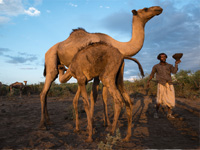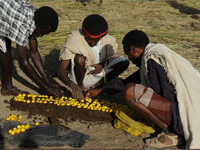Projects
Descriptions of Our Major Projects
This particular section of our website is devoted to access visitors with brief descriptions of key projects of the organization. Hence, throughout this section some projects will be described in glance regarding their ultimate goals to be achieved at mid or completion of their life period. In addition to their overall objectives the projects will be also described based on their justifications.
On the other hands projects can be also described from communities (beneficiaries') points of view. From this dimension, the description of our projects will take a look at the communities' point of view. This is to answer some basic questions related to attitudes of community towards the particular projects.
Community Gardens
Slow Food Foundation for Biodiversity supports this project
Our project entitled as community gardening is designed to encourage and facilitate the community gardens building across Karrayyu land in general and Galcha Kebele in particular. In one way or other the operation of this project resides in one or more of the following guiding principles: - Community gardening as community Building engine: Karrayyu's have been self-sustained group of people before the restriction of access to graze land due to commercial construction or environmental degradation as a result of over grazing. This community garden in Galcha is part of bringing back their sense of pride and integrity. So, they can go back to supporting their own way of life granted that it is a shift from pastoralist to small farming. The change that is necessary to secure their way of life. Thus, community garden will be able to provide the opportunity for all residents of Galcha to engage in the process of small farming. Our goal is to support all members of the kebele that want to be involved in gardening by providing safe, sustainable land at an affordable price. We will also provide them with ongoing support with equipments, mentoring if needed and a garden manager to oversee the running of the entire project. - Community gardening as a Source of Locally Sponsored way of life: community gardens help individuals and social support institutions to run their day-to-day life based on home grown foods and also provide a locally sponsored source of health due to ease access to clean and safe local foods in our garden. - Community gardening as environment friendly project: community gardening is considered to be as one of environment friendly project since it tries to provide a means of lowering our carbon footprint by using local instead of imported food. In this way we as a community can say that we are doing our part to mitigate climate change. In particular it would help with creating a different kind of relationship between the residents and their environment which would help mitigate poor condition of the land in a long run. Thus, the change that will occur is both beneficial and aesthetically pleasing. In order for this transformation to occur learning new techniques and skills are crucial. The garden is a gateway to expand our knowledge and understanding as to how to preserve and maintain balanced environment. We learn to differentiate the value and vulnerability of fresh water and differentiate between the safety of organically grown food and that of commercially grown monoculture products that have been treated with pesticides. Based on the above mentioned guiding principles our community gardening holds the following values and action statements at the center of its project:
1. Valuing life in all forms: our gardens activities should operate in organic (permaculture)
2. Valuing clean and safe water, food and the earth that sustain us
3. Valuing community and the rich, positive dialogue that gardens can encourage throughout the community
4. Valuing the enrichment of lives that clean, good, healthy gardening offers
Tree Planting Project
This project is supported by Wales Africa Community Links - Wales Size and OSHO/CSSP - British Council
As our environment continued to degrade and global warming continued to skyrocket, the ozone layer fast depleting, the need for young people to get involved in tackling the problems of environmental instability and global warming is at hand, hence the project "Tree Planting" seems very important at this point. Accordingly our primary goal to be achieved within this project is to promote environmental sustainability and adequately creates awareness on the dangers of Climate Change and how to prevent them through tree planting. Even though it is important to maintain a good ecosystem all over the world, it is crucial for the Karrayyu community in particular, because they directly relay on their environment for their survivor on way or the other. Trees can reduce the temperature of the area by the chemical process of changing water from the leaves into vapor, which would drastically change the intolerable current temperatures. The falling tree leaves can reduce soil temperature and soil moisture loss, which is necessary to support new growth. Decaying leaves promotes soil microorganisms and provide nutrient for growth while enriching the social. Trees can help off set the build up of carbon dioxide in the air and reduce the "greenhouse" effect. Most of all trees create ecosystems and provide habitats and food for various animals. Because of all these benefits and more tee planting project is crucial for the transformation the Karrayyu community into a new way of life. For the sake of this particular project Tree planting is the process of transplanting tree seedlings, generally for forestry, land reclamation, or landscaping purposes. It differs from the transplantation of larger trees in arboriculture, and from the lower cost but slower and less reliable distribution of tree seeds. Thus in one way or other our project rely on the philosophy that follows the argument that perceive Tree planting as grounded in forest science, and if performed properly can result in the successful regeneration of a deforested area. Generally speaking the project under consideration is designed to create awareness, educate as well as entertain the participants and the society at large in general and the following points in particular.
- To enhance environmental sustainability.
- To encourage youths to associate more on issues of environmental degradation and global warming.
- To freely distribute economic trees so as to increase the economy of the beneficiaries at the long run.
- To link young people and stakeholders together and create an avenue for interactions in environmental related issues.
Camel Milk

Slow Food Foundation for Biodiversity funds this project
Throughout the developing world in general and for Karrayyu in particular nomadic and farming communities milk camels in subsistence model. Our organization recognises that with the development of stronger market links, these subsistence activities could increase, formalise, and become an economic drive that has cultural relevance, produces an entire industry chain of jobs, and all through that holds great nutritional benefits. Beside this it's important to take into consideration that the level of camel milk production, and thus the availability of milk for sale, depends heavily on rainfall and pasture conditions and varies strongly between seasons and years. Moreover, the decision to sale camel milk is influenced by the availability of cow and goat milk for household consumption, and on the availability of alternative sources of cash income (migrant labour, sale of livestock and grains). However the area, there is only a market for camel milk, but cow milk can be processed into ghee for sale. Generally speaking our organization aims to catalyse the long overlooked camel milk revolution by combining our skills in business, media, and movement making. We will revive the practice of camel-milk through sharing dairy blueprints, skills and knowledge in a franchise model, empowering herders to move from substance to supplier, of product that is already gaining a following as a "Super Food" in world. Our goal is to commercialize the sale of camel milk, educate consumers about its benefits, distribute it around the world and market it as the next "Super Food". Accordingly, our project combines entrepreneurs, filmmakers and leaders of social change to tackle the challenge of food insecurity by creating a huge demand of camel milk products worldwide and encourage countries that are blessed with abundance of camels to take control of the production camel milk before we see another case of multinationals once again exploiting a rare commodity.
Why Camel Milk?
Unlike other milks, camel's milk is a complete food that can be consumed exclusively while meeting all nutritional requirements. It's rich in fatty acids, its rich in Vitamin B and D and has 10 times more iron and protein than cow's milk. It's naturally homogenized, contains a large amount of insulin, and is anti-allergy which is thought to be particularly beneficial to diabetics and children with autism. Camel's milk has recently been seen as an unprecedented surge in popularity with more people discovering the health benefits that nutrient rich camel milk delivers.
Saving Sacred Ritual Sites

The Christensen Fund supprts this project
The ultimate concern of this project is to bring a recently designed approach of development that favours the interrelationship between environment and religion by one aspect and \anthropology and religion on other aspect. Hence, based on its primary objective our project relies largely on observations from anthropology and religious studies on one side and from ecology and religious studies on other hand to explore some impressive cases of created eco-rituals, or rituals produced in a context of activist ecological spiritualities. These two solid segments will guide our road to implement this project. We use ritual sites and ritual activities effectively to motivate environmental consciousness, protection, and restoration with locally known strategies of tree-ordination and earth-keeping to get success in ritualizing multiple environmental initiatives. We also notice that ritualizing environment can also motivate the community to protect and restore local landscapes. Thus, we consider the location, adaptation and/or recreation of old rituals and ritual sites in new contexts designed explicitly to enhance environmental consciousness and alter behaviors that have been environmentally destructive. All in all this project demonstrates some of the ways that traditions, religious values and ritual practices may be effectively and benignly employed to help solve new problems in new contexts. Most lessons that someone ought to learn from our organization at this point may be something like: learn from the people you are working with, as you go along; and never be afraid to rethink strategies, renegotiate practices, and redistribute authority. It is undeniable that this project readily evokes our admiration for an ongoing community project that was not only well conceived but has remained permeable to multiple perspectives, and mutable along with changing needs, circumstances and populations. Best of all, the multifaceted project has evidently succeeded in being genuinely productive of heightened consciousness of environmental problems. This project as a case also demonstrates how collective well-being may be promoted through tapping youthful energy, in conjunction with serious attention to, and respect for, elders' knowledge and authority. Generally speaking we focus on religion in this context to save the earth through employing the newly developing assumptions of spiritual ecology. Spiritual ecology declares without reservations, that religion has the potential to provide a worldview, values, attitudes, practices, rituals [our emphasis], institutions, and sacred places (our concerns)for the effective development of a vibrant and adaptive spiritual ecology.





